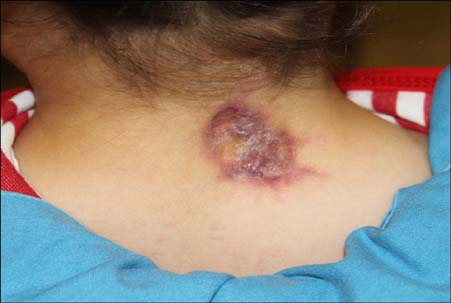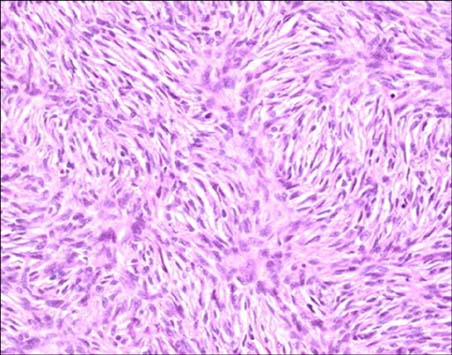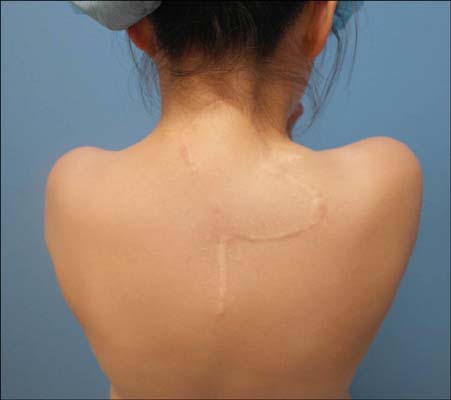Ann Dermatol.
2015 Oct;27(5):597-600. 10.5021/ad.2015.27.5.597.
Congenital Dermatofibrosarcoma Protuberans: A Case Report and Literature Review
- Affiliations
-
- 1Department of Plastic and Reconstructive Surgery, College of Medicine, The Catholic University of Korea, Seoul, Korea. rhie@catholic.ac.kr
- 2Department of Dermatology, College of Medicine, The Catholic University of Korea, Seoul, Korea.
- KMID: 2171460
- DOI: http://doi.org/10.5021/ad.2015.27.5.597
Abstract
- Congenital dermatofibrosarcoma protuberans (DFSP) is an extremely rare skin tumor that is commonly misdiagnosed, or is often diagnosed long after the initial presentation. Although many cases of DFSP are diagnosed in adulthood, there are some differences between adult DFSP and congenital DFSP. We report a case of congenital DFSP that was initially misdiagnosed as a simple vascular lesion. The delay in diagnosis led to the considerable growth of the lesion, such that a huge scar was left after the surgical treatment. The major differences between adult and congenital DFSP are discussed through a literature review. Clinicians should be aware of the characteristics of congenital DFSP, to reduce misdiagnosis and the delay of diagnosis from the initial presentation.
Keyword
Figure
Reference
-
1. Navarro M, Requena C, Febrer I, Marin S, Aliaga A. Dermatofibrosarcoma protuberans with onset in early childhood: a case report. J Eur Acad Dermatol Venereol. 2002; 16:154–155.
Article2. Reddy C, Hayward P, Thompson P, Kan A. Dermatofibrosarcoma protuberans in children. J Plast Reconstr Aesthet Surg. 2009; 62:819–823.
Article3. Jafarian F, McCuaig C, Kokta V, Laberge L, Ben Nejma B. Dermatofibrosarcoma protuberans in childhood and adolescence: report of eight patients. Pediatr Dermatol. 2008; 25:317–325.
Article4. Bendix-Hansen K, Myhre-Jensen O, Kaae S. Dermatofibrosarcoma protuberans. A clinico-pathological study of nineteen cases and review of world literature. Scand J Plast Reconstr Surg. 1983; 17:247–252.
Article5. Goldblum JR, Folpe AL, Weiss SW. Fibrohistiocytic tumors of intermediate malignancy. In : Goldblum JR, Folpe AL, Weiss SW, editors. Enzinger and Weiss's soft tissue tumors. 6th ed. St. Louis: CV Mosby;2014. p. 387–420.6. Taylor HB, Helwig EB. Dermatofibrosarcoma protuberans. A study of 115 cases. Cancer. 1962; 15:717–725.
Article7. McPeak CJ, Cruz T, Nicastri AD. Dermatofibrosarcoma protuberans: an analysis of 86 cases--five with metastasis. Ann Surg. 1967; 166:803–816.8. Burkhardt BR, Soule EH, Winkelmann RK, Ivins JC. Dermatofibrosarcoma protuberans. Study of fifty-six cases. Am J Surg. 1966; 111:638–644.9. Gloster HM Jr. Dermatofibrosarcoma protuberans. J Am Acad Dermatol. 1996; 35:355–374.
Article10. Weinstein JM, Drolet BA, Esterly NB, Rogers M, Bauer BS, Wagner AM, et al. Congenital dermatofibrosarcoma protuberans: variability in presentation. Arch Dermatol. 2003; 139:207–211.11. Pack GT, Tabah EJ. Dermato-fibrosarcoma protuberans. A report of 39 cases. AMA Arch Surg. 1951; 62:391–411.12. Cohen PR, Rapin RP, Farhood AI. Dermatofibroma and dermatofibrosarcoma protuberans: differential expression of CD34 and factor XIIIa. Am J Dermatopathol. 1994; 16:573–574.13. Prieto VG, Reed JA, Shea CR. CD34 immunoreactivity distinguishes between scar tissue and residual tumor in re-excisional specimens of dermatofibrosarcoma protuberans. J Cutan Pathol. 1994; 21:324–329.
Article14. Rubin BP, Schuetze SM, Eary JF, Norwood TH, Mirza S, Conrad EU, et al. Molecular targeting of platelet-derived growth factor B by imatinib mesylate in a patient with metastatic dermatofibrosarcoma protuberans. J Clin Oncol. 2002; 20:3586–3591.
Article15. Ballo MT, Zagars GK, Pisters P, Pollack A. The role of radiation therapy in the management of dermatofibrosarcoma protuberans. Int J Radiat Oncol Biol Phys. 1998; 40:823–827.
Article
- Full Text Links
- Actions
-
Cited
- CITED
-
- Close
- Share
- Similar articles
-
- Congenital Dermatofibrosarcoma Protuberans: A Case Report
- Dermatofibrosarcoma Protuberans Arising froma Burn Scar
- Congenital Dermatofibrosarcoma Protuberans Treated with Wide Excision
- Comments to “Pigmented Dermatofibrosarcoma Protuberans Presenting as a Faint Blue Macule in a Middle-aged Korean Womanâ€
- A Case of Dermatofibrosarcoma Protuberans as a Subcutaneous Nodule without Surface Change




